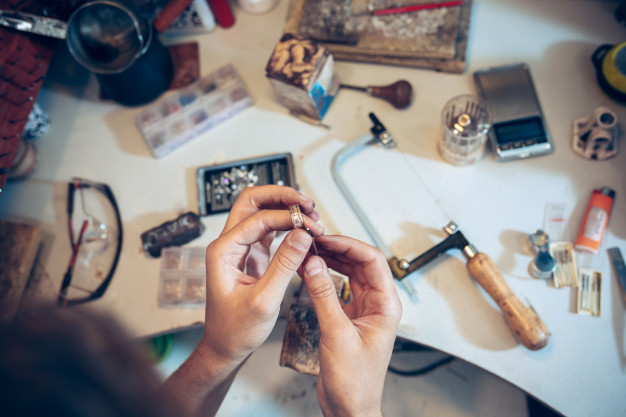

Jewellery is an elegant metal item (traditionally) with intricate stones and decoration that reflects the wearer’s class and style. It is a reflection of a person’s personal style and personality. It’s a masterpiece. Necklaces, brooches, bracelets, anklets, sterling rings, statement rings, cocktail rings, watches, earrings, ear studs, nose pins, and nose rings are common in today’s culture.
A prehistoric Neanderthal made the first piece of jewellery out of seashells and beads 115,000 years ago (a previous generation of extinct archaic humans). Several civilizations have come since then, and their jewellery has been embraced. The Egyptian dynasty, for example, produced jewellery that is noted for its huge designs with massive decoration, made entirely of gold and precious and rare stones, and dating back 5000 years. It was a symbol of religious and political power.
The Greeks also used gold, amethysts, pearls, and emeralds in 500 BC to reflect a vivid yet sophisticated age of jewellery worn to show riches and prestige. Romans wore delicate fabrics, particularly brooches, to tie their clothing, to ward off the evil eye. During the Renaissance, many civilizations collided in Europe. Only the most delicate, complex, and exquisite jewellery appeared to represent the grandeur and magnificence of the greatest society of artists and their admirers ever to live.
For artistic people and who have a strong understanding of precious stones and gems, jewellery making can be a fun activity. However, you cannot begin making jewellery without any prior experience or expertise. Before going on to the advanced levels, you must first learn the fundamentals and many other fields.
Since the discovery of art, jewellery-making techniques have evolved significantly. Since the dawn of time, jewellers have been inspired by intricate designs made from precious metals, beads, and stones. Jewellers use a variety of mechanisms to develop their jewellery-making methods after the advent of cutting-edge technologies. No matter how advanced technology advances, you must master the fundamentals of jewellery making.
Bead Stringing Techniques
If you carefully examine the pages of history, you can discover that beaded jewellery is the oldest form of jewellery. As a result, learning how to string beads is an essential part of the jewellery-making process. As part of your bead stringing class, you can learn both conventional and advanced knotting techniques. You may need this ability when making Custom Design Jewellery. You should be able to cover your crimp beads and finish your work using various finishing techniques, among other things. Exquisite Jewellers, a skilled and knowledgeable jeweller, will assist you in learning this jeweller’s techniques with the utmost care.
Metal Clay Techniques
If you want to learn how to make ornaments, you will learn metal clay techniques. Metal clay can be used in a variety of ways to create intricate and beautiful jewellery. If you want to work in the industry, you’ll need to know how to use the firing clay process, texturing metal clay, rolling and stamping the clay, and stuffing.
Wirework Techniques
If you follow the crowd, you’ll notice that wired jewellery is in high demand. People worldwide are enamoured with these ornaments’ exotic and glamorous look, even though the design is traditional. If you want to make jewellery a full-time job, you can devote yourself to learning the wirework process. Under the broad category of wire jewellery making, there are various ways and fields to learn about, all of which need careful attention. Looping wires, making briolette pendants, efficiently resolving jump ring problems, wire knitting, and other essential fields are among them.
Fabrication Techniques
You are not a good jeweller if you do not know how to work with metal. Fabrication is just as essential as the other methods. To treat the jewellery metal like a pro, you’ll need to learn the technique. Fabrication can range from oxidation to modern jewellery techniques to give jewellery a unique look and feel.
You may also try your hand at learning how to make hand-crafted jewellery. These ornaments are one-of-a-kind and creative. They have a bright future ahead of them in the jewellery industry.
If you’re interested in jewellery designing or choose to pursue it as a profession. In that case, you’ll need to obtain a proper degree from a reputable university to earn a respectable jewellery designer salary. JD Institute is one of the best institutes for jewellery designing courses with affordable jewellery designing fees, such as a diploma in jewellery design. With an industry-based programme or approach, so that its students can stand out from the crowd and pave a way where there is a lot of scope for jewellery designing.
JD Institute shares the mission of offering the best infrastructure, technologies, and services so that external factors in achieving its objectives do not limit its students. They have been honoured with numerous tokens of appreciation for their extraordinary contribution to education and record-breaking placement, with 99 per cent of their students working for top firms and making a name for themselves in the industry, including the international glory award, leaders in education award, the times’ power icon award, and several others. Candidates are selected using a general aptitude test (GAT) created by the department to assess their technical or imaginative abilities.
The JD council will assist you with contacting the college and other students following graduation and offering constructive guidance. It symbolizes the organization’s goal of helping participants extend their business potential through a well-organized, positive, and qualified referral network that helps them form productive and long-term relationships with quality industry professionals. To take advantage of this wonderful opportunity, Enroll now!